The AI-powered care coordination industry stands at the threshold of a decade-long expansion trajectory that promises to reshape healthcare delivery and patient management technology. The market's journey from USD 651.1 million in 2025 to USD 1305.0 million by 2035 represents substantial growth, demonstrating the accelerating adoption of artificial intelligence solutions and integrated care management systems across healthcare providers, payer organizations, and digital health platforms.
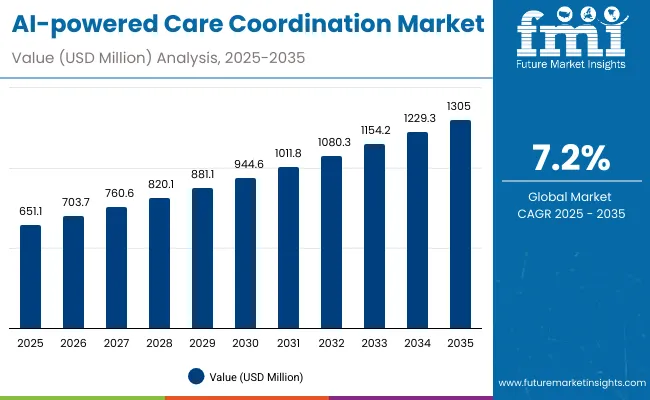
AI-powered Care Coordination Market Key Takeaways
| Metric | Value |
|---|---|
| Market Value (2025) | USD 651.1 million |
| Market Forecast (2035) | USD 1305.0 million |
| Growth Rate | 7.2% CAGR |
| Leading Deployment Model | Cloud-based SaaS |
| Primary Clinical Pathway | Acute & Emergency Care |
The first half of the decade (2025-2030) will witness the market climbing from USD 651.1 million to approximately USD 921.8 million, adding USD 270.7 million in value, which constitutes 41.4% of the total forecast growth period. This phase will be characterised by the rapid adoption of cloud-based AI platforms, driven by increasing healthcare digitization and care coordination complexities worldwide. Advanced machine learning capabilities and predictive analytics will become standard expectations rather than premium features.
The latter half (2030-2035) will witness accelerated growth from USD 921.8 million to USD 1305.0 million, representing an addition of USD 383.2 million or 58.6% of the decade's expansion. This period will be defined by mass market penetration of AI-driven care coordination systems, integration with comprehensive electronic health records, and seamless compatibility with existing healthcare infrastructure. The market trajectory signals fundamental shifts in how healthcare organizations approach patient care management, with participants positioned to benefit from sustained demand across multiple clinical pathway segments.
The AI-powered Care Coordination market demonstrates distinct growth phases with varying market characteristics and competitive dynamics. Between 2025 and 2030, the market progresses through its digital transformation phase, expanding from USD 651.1 million to USD 921.8 million with steady annual increments averaging 7.1% growth. This period showcases the transition from basic care coordination tools to sophisticated AI-driven platforms with enhanced predictive capabilities and integrated clinical decision support becoming mainstream features.
The 2025-2030 phase adds USD 270.7 million to market value, representing 41.4% of total decade expansion. Market maturation factors include standardisation of AI deployment protocols, declining costs for machine learning infrastructure, and increasing healthcare provider awareness of care coordination benefits reaching 85-90% effectiveness in patient outcome improvement applications. Competitive landscape evolution during this period features established healthcare technology companies expanding their AI portfolios while new entrants focus on specialized clinical pathways and enhanced interoperability solutions.
From 2030 to 2035, market dynamics shift toward advanced integration and multi-system deployment, with growth accelerating from USD 921.8 million to USD 1305.0 million, adding USD 383.2 million or 58.6% of total expansion. This phase transition centres on advanced AI algorithms, integration with population health management platforms, and deployment across diverse healthcare scenarios, becoming standard rather than specialized applications. The competitive environment matures with focus shifting from basic care coordination to comprehensive patient journey management and integration with value-based care models.
The market demonstrates strong fundamentals with cloud-based SaaS deployment models capturing a dominant 62.2% share through scalable infrastructure and cost-effective implementation capabilities. Acute & Emergency care applications drive primary demand with 31.2% market share, supported by increasing healthcare system complexity and critical care management requirements. Geographic expansion remains concentrated in developed markets with established healthcare infrastructure, while emerging economies show accelerating adoption rates driven by healthcare modernization and digital transformation initiatives.
The AI-powered care coordination market represents a compelling intersection of artificial intelligence, healthcare delivery optimization, and patient outcome improvement. With robust growth projected from USD 651.1 million in 2025 to USD 1305.0 million by 2035 at a 7.2% CAGR, this market is driven by increasing healthcare costs, provider workflow complexities, and regulatory pressures for improved care quality and coordination.
The market's expansion reflects a fundamental shift in how healthcare organizations approach patient care management and clinical workflow optimization. Strong growth opportunities exist across diverse applications, from acute care requiring real-time decision support to chronic disease management demanding longitudinal patient monitoring. Geographic expansion is particularly pronounced in Asia-Pacific markets, led by South Korea (9.4% CAGR) and India (5.4% CAGR), while established markets in North America and Europe drive premium positioning and technology innovation.
The dominance of cloud-based deployment models and acute care applications underscores the importance of scalable infrastructure and critical care management in driving adoption. Integration complexity and data privacy concerns remain key challenges, creating opportunities for companies that can simplify deployment while maintaining security standards.
Market expansion rests on four fundamental shifts driving adoption across healthcare provider and payer sectors. Healthcare cost pressures create compelling economic advantages through AI-powered care coordination systems that reduce redundant procedures, prevent readmissions, and optimize resource utilization, enabling healthcare organizations to improve financial performance while maintaining quality care delivery. Clinical workflow complexity intensifies as healthcare providers seek integrated solutions that streamline patient management across multiple specialties, enabling coordinated care delivery that reduces medical errors and improves patient satisfaction.
Regulatory requirements accelerate adoption as government mandates for care quality reporting and value-based payment models drive demand for comprehensive coordination platforms that demonstrate measurable outcomes and compliance capabilities. Patient outcome improvement becomes paramount as healthcare organizations recognize AI's potential to enhance clinical decision-making, predict adverse events, and optimize treatment pathways for better health results.
However, growth faces headwinds from integration complexity challenges that vary across healthcare systems regarding existing technology infrastructure and workflow disruption, potentially limiting deployment flexibility in certain organizational environments. Data privacy and security concerns also persist regarding patient health information protection and regulatory compliance that may increase implementation costs and restrict data sharing capabilities.
Primary Classification: The market segments by clinical pathway into Acute & Emergency, Chronic Disease Management, Oncology Care Coordination, Behavioral Health & Mental Health, and Preventive & Population Health categories, representing the evolution from episodic care to comprehensive patient journey management.
Secondary Breakdown: Data source segmentation divides the market into Imaging-based AI, EHR/Clinical Data, Claims & Payer Data, Remote Monitoring & Wearables, and Social Determinants of Health sectors, reflecting distinct information inputs for comprehensive care coordination analytics.
Tertiary Classification: Deployment model segmentation covers Cloud-based SaaS, On-premise, and Hybrid Models, with cloud solutions leading adoption while emerging hybrid approaches show accelerating growth patterns driven by security and compliance requirements.
The segmentation structure reveals technology progression from basic care coordination systems toward integrated AI platforms with comprehensive data analytics and predictive capabilities, while deployment diversity spans from traditional on-premise installations to modern cloud-native solutions requiring distinct implementation strategies.
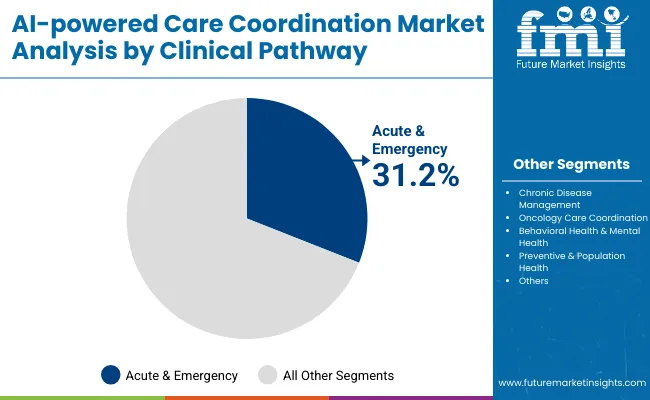
Market Position: Acute & Emergency care coordination commands the leading position in the AI-powered Care Coordination market through critical decision support capabilities, including real-time patient monitoring, emergency response optimization, and cross-departmental communication systems that enable healthcare providers to deliver timely, coordinated care during high-stakes clinical scenarios.
Value Drivers: The segment benefits from healthcare provider prioritization of patient safety and emergency response efficiency that provides immediate clinical value through reduced response times and improved patient outcomes. High-stakes clinical environments enable premium pricing for AI solutions that demonstrate measurable improvements in emergency care delivery and patient survival rates.
Competitive Advantages: Acute care systems differentiate through rapid deployment capabilities, proven clinical effectiveness, and integration with existing emergency medical systems that enhance care coordination while maintaining compliance with critical care protocols suitable for diverse hospital environments.
Key market characteristics
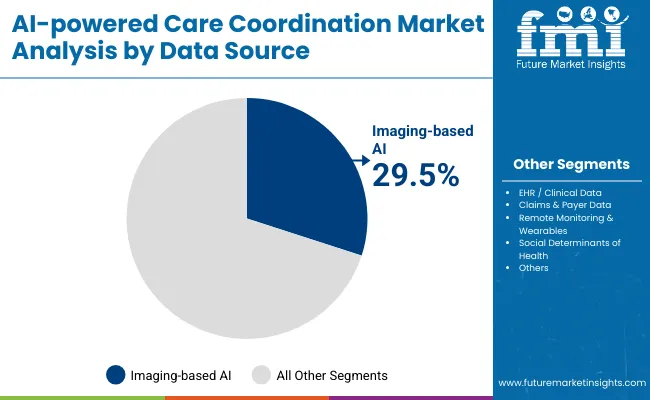
Market Context: Imaging-based AI dominates the AI-powered Care Coordination market due to widespread adoption of medical imaging technologies and increasing demand for automated image analysis, radiological workflow optimization applications that maximize diagnostic accuracy while enabling rapid clinical decision-making across multiple medical specialties.
Appeal Factors: Healthcare providers prioritise imaging AI solutions that provide immediate diagnostic insights, automated anomaly detection, and integration with existing radiology workflows that enable coordinated care delivery. The segment benefits from substantial imaging equipment investments and modernization programs that emphasise diagnostic efficiency and accuracy for clinical coordination applications.
Growth Drivers: Medical imaging modernization programs incorporate AI-powered analysis as standard diagnostic enhancement alongside traditional imaging equipment. At the same time, radiologist workflow optimization initiatives increase demand for automated systems that support coordinated care delivery across medical specialties.
Market Challenges: Technology integration requirements and radiologist workflow adaptation may limit deployment speed in certain healthcare environments.
Data source dynamics include
Growth Accelerators: Healthcare digitization drives primary adoption as AI-powered care coordination platforms provide comprehensive patient data integration and clinical workflow optimization that enable seamless care delivery across multiple providers and specialties, supporting improved patient outcomes and operational efficiency.
Value-based care transition accelerates market expansion as healthcare organizations seek integrated solutions that demonstrate measurable quality improvements while reducing costs through coordinated care management and preventive intervention capabilities. Clinical decision support enhancement increases demand for AI systems that provide real-time analytics, predictive insights, and evidence-based recommendations that improve clinician productivity and reduce medical errors across complex care scenarios.
Growth Inhibitors: Implementation complexity challenges vary across healthcare organizations regarding existing system integration, workflow adaptation, and staff training requirements that may limit deployment flexibility and extend adoption timelines in certain institutional environments. Data privacy and interoperability concerns persist regarding patient health information security, regulatory compliance, and cross-system data sharing that may increase implementation costs and restrict comprehensive care coordination capabilities. Technology adoption resistance among healthcare providers may slow market penetration where clinical workflow disruption and learning curve requirements create organizational barriers to AI platform implementation.
Market Evolution Patterns: Adoption accelerates in large healthcare systems where comprehensive care coordination justifies technology investments, with geographic expansion transitioning toward community healthcare adoption driven by interoperability improvements and cost-effective deployment models. Technology development focuses on enhanced AI algorithms, improved predictive capabilities, and integration with emerging healthcare technologies that optimize clinical outcomes and operational efficiency. The market could face disruption if healthcare regulatory changes significantly restrict AI clinical applications or if alternative care coordination technologies develop superior integration capabilities at competitive pricing levels.
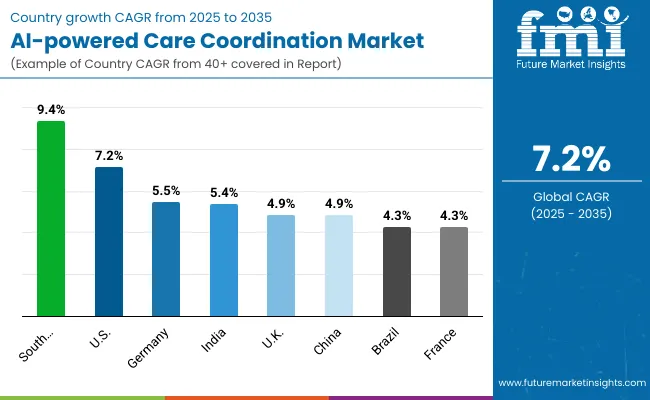
| Country | CAGR (2025 to 2035) |
|---|---|
| South Korea | 9.4% |
| USA | 7.2% |
| Germany | 5.5% |
| India | 5.4% |
| UK | 4.9% |
| China | 4.9% |
| Brazil | 4.3% |
| France | 4.3% |
The AI-powered Care Coordination market demonstrates varied regional dynamics with Growth Leaders including South Korea (9.4% CAGR) and USA (7.2% CAGR) driving expansion through healthcare digitization and advanced technology adoption. Steady Performers encompass Germany (5.5% CAGR), India (5.4% CAGR), and Europe overall (5.3% CAGR), benefiting from established healthcare infrastructure and regulatory support for AI technologies. Emerging Markets feature UK (4.9% CAGR), China (4.9% CAGR), and Brazil (4.3% CAGR), where healthcare modernization and technology integration support consistent growth patterns.
Regional synthesis reveals Asia-Pacific markets leading growth through healthcare modernization and technology adoption initiatives, while North American markets maintain strong expansion supported by advanced healthcare infrastructure and AI technology investment. European countries show steady performance driven by regulatory frameworks and comprehensive healthcare system integration trends.
South Korea establishes exceptional market leadership through comprehensive healthcare digitization programs and advanced AI technology integration, implementing sophisticated care coordination systems as standard components in hospital and clinic applications. The country's 9.4% CAGR through 2035 reflects government initiatives promoting healthcare technology adoption and domestic AI development capabilities that mandate integrated care coordination systems in medical institutions and healthcare facilities. Growth concentrates in major medical centres, including Seoul, Busan, and Daegu, where healthcare modernization showcases advanced AI coordination systems that appeal to providers seeking comprehensive patient management solutions and clinical efficiency applications.
Korean healthcare technology companies are developing innovative AI-powered care coordination solutions that combine traditional medical practices with advanced machine learning algorithms, including predictive analytics and automated workflow systems.
Strategic Market Indicators
In major medical centres across New York, California, and Texas, healthcare systems and medical institutions are implementing comprehensive AI-powered care coordination platforms as standard technology for clinical workflow optimization and patient outcome improvement applications, driven by increasing healthcare costs and quality improvement initiatives that emphasise coordinated care delivery capabilities.
The market is projected to demonstrate a 7.2% CAGR through 2035, supported by federal healthcare initiatives and institutional modernization programs that promote AI technology adoption for comprehensive care management. American healthcare providers are adopting AI coordination systems that provide superior clinical decision support and operational efficiency benefits, particularly appealing in complex medical environments where care coordination represents critical quality requirements.
Market expansion benefits from established healthcare technology infrastructure and strong institutional investment in AI solutions that enable widespread deployment across hospital systems and healthcare networks.
Market Intelligence Brief
Germany's advanced healthcare technology market demonstrates sophisticated AI-powered care coordination deployment with documented clinical effectiveness in hospital systems and medical practice applications through integration with existing healthcare management systems and clinical protocols. The country leverages healthcare engineering expertise and medical technology innovation to maintain a 5.5% CAGR through 2035. Medical centres, including Berlin, Munich, and Hamburg, showcase premium installations where AI coordination platforms integrate with comprehensive hospital information systems and clinical workflow management to optimise patient care delivery and operational effectiveness.
German healthcare institutions prioritise system reliability and clinical evidence in AI care coordination development, creating demand for premium platforms with advanced clinical validation, including outcome measurement capabilities and integration with evidence-based medicine protocols. The market benefits from established medical technology infrastructure and institutional willingness to invest in proven healthcare AI technologies that provide long-term clinical benefits and regulatory compliance.
Market Intelligence Brief
India demonstrates robust market development with a 5.4% CAGR through 2035, supported by comprehensive healthcare modernization programs and government initiatives promoting digital health technology adoption across urban and rural healthcare delivery systems. The market benefits from increasing healthcare infrastructure investment and growing recognition of AI coordination benefits for addressing healthcare access challenges and clinical efficiency requirements in resource-constrained environments.
Market dynamics focus on cost-effective AI coordination solutions that balance advanced clinical capabilities with affordability considerations important to Indian healthcare providers. Growing medical tourism and private healthcare development creates sustained demand for modern care coordination systems in hospital infrastructure and specialty care applications.
Strategic Market Considerations
The UK market emphasises advanced AI-powered care coordination features, including comprehensive patient data integration and clinical pathway optimization that manage care delivery across National Health Service facilities and private healthcare providers through unified healthcare information systems. The country is projected to show a 4.9% CAGR through 2035, driven by NHS modernization programs and institutional demand for integrated care coordination systems that deliver measurable clinical outcomes. British healthcare providers prioritise operational effectiveness with AI coordination platforms delivering consistent care quality through advanced clinical algorithms and healthcare delivery optimization capabilities.
Technology deployment channels include major healthcare system suppliers, specialized medical technology companies, and NHS procurement programs that support professional implementation for complex healthcare applications.
Performance Metrics
In Beijing, Shanghai, and other major medical centres, Chinese healthcare institutions and hospital systems are implementing advanced AI-powered care coordination systems to enhance clinical efficiency and support healthcare modernization that aligns with national health technology development goals and medical service quality improvement protocols.
The Chinese market demonstrates steady growth with a 4.9% CAGR through 2035, driven by healthcare infrastructure development programs and institutional investment in medical technology that emphasises comprehensive care coordination for hospital systems and medical practice applications. Chinese healthcare facilities are prioritising AI coordination platforms that provide reliable clinical support capabilities while maintaining compliance with national healthcare standards and operational efficiency requirements, particularly important in urban medical centres and specialty hospital operations.
Market expansion benefits from government healthcare technology procurement programs that mandate advanced coordination systems in public healthcare facility specifications, creating sustained demand across China's hospital and clinical care sectors, where operational efficiency and care quality represent critical institutional requirements.
Strategic Market Indicators
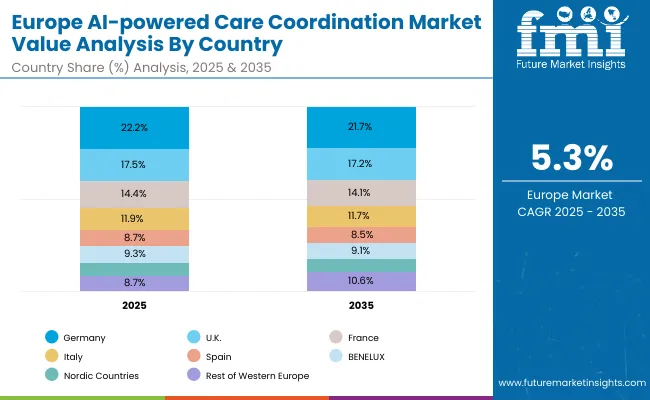
The AI-powered Care Coordination market in Europe is projected to grow from USD 182.3 million in 2025 to USD 305.0 million by 2035, registering a CAGR of 5.3% over the forecast period. Germany is expected to maintain its leadership position with a 22.2% market share in 2025, declining slightly to 21.7% by 2035, supported by its advanced healthcare technology infrastructure and major medical centres, including Berlin and Munich.
United Kingdom follows with a 17.5% share in 2025, projected to reach 17.2% by 2035, driven by NHS modernization programs and comprehensive healthcare system integration initiatives. France holds a 14.4% share in 2025, expected to maintain 14.1% by 2035 through specialized healthcare applications and medical technology development. Italy commands an 11.9% share, while Spain accounts for 8.7% in 2025. BENELUX region holds 9.3% share, Nordic Countries account for 7.2%, and the Rest of Western Europe region is anticipated to gain momentum, expanding its collective share from 8.7% to 10.6% by 2035.
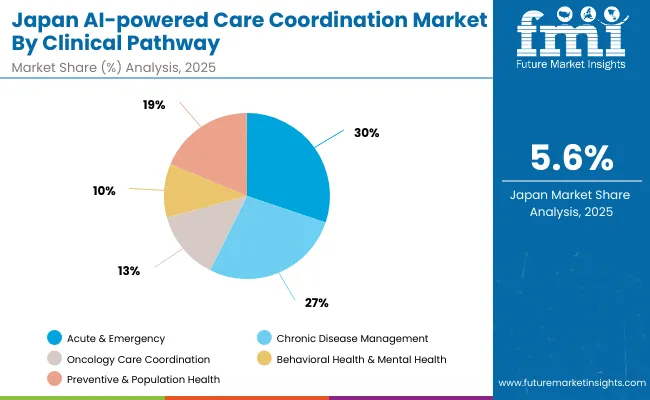
In Japan, the AI-powered Care Coordination market prioritises Cloud-based SaaS deployment models, which capture the dominant share of hospital and clinic installations through scalable infrastructure capabilities and seamless integration with existing healthcare management systems. Japanese healthcare providers emphasise system reliability, clinical effectiveness, and long-term operational support, creating demand for cloud-based platforms that provide comprehensive care coordination capabilities and adaptive clinical workflow control based on institutional requirements and patient management scenarios.
On-premise deployment systems maintain secondary market positions primarily in specialized healthcare applications and research institutions where data sovereignty meets operational requirements without compromising clinical functionality.
Market Characteristics
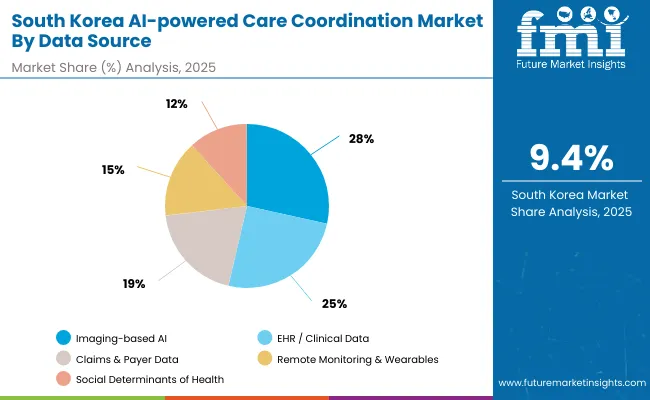
In South Korea, the market structure demonstrates strong preference for Imaging-based AI data sources, which maintain 28.5% market share through comprehensive diagnostic integration and advanced medical imaging analysis capabilities supporting coordinated care delivery across multiple clinical specialties. These systems offer integrated solutions combining sophisticated image analysis algorithms with clinical decision support platforms and real-time coordination capabilities that appeal to Korean healthcare providers seeking comprehensive diagnostic and care management solutions.
EHR/Clinical Data systems capture 25.2% market share by providing clinical information integration and workflow optimization. At the same time, Claims & Payer Data sources focus on utilization management and outcome measurement solutions tailored to Korean healthcare reimbursement characteristics.
Application Insights
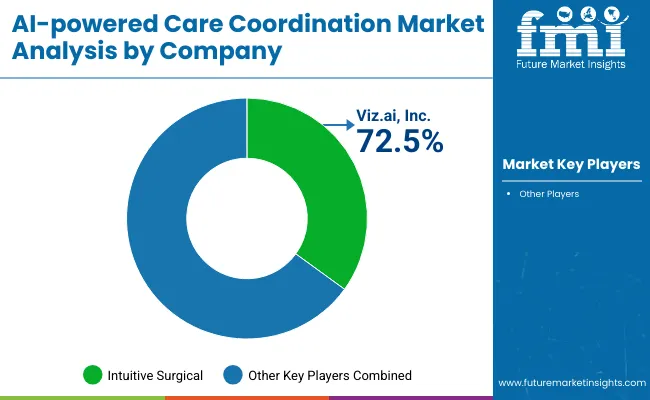
The AI-powered Care Coordination market operates with high concentration, featuring approximately 12-18 meaningful participants, where leading companies control roughly 60-70% of the global market share through established healthcare relationships and comprehensive AI technology portfolios. Competition emphasises clinical effectiveness, system integration capabilities, and regulatory compliance rather than price-based rivalry alone.
Market Leaders encompass Viz.ai Inc., Philips maintain competitive advantages through extensive healthcare technology expertise, global provider networks, and comprehensive AI development capabilities that create customer loyalty and support premium positioning. These companies leverage advanced machine learning technologies and ongoing clinical research investments to develop superior AI coordination platforms with enhanced predictive capabilities and clinical outcome improvements.
Technology Innovators include Epic Systems Corporation, Merative, and Siemens Healthineers, which compete through specialized AI algorithms and innovative healthcare integration solutions that appeal to providers seeking advanced clinical decision support and comprehensive care coordination capabilities. These companies differentiate through rapid AI development cycles and specialized healthcare application focus.
Market dynamics favour participants that combine proven clinical effectiveness with comprehensive healthcare system integration, including interoperability standards and regulatory compliance capabilities. Competitive pressure intensifies as traditional healthcare IT companies expand into AI solutions. At the same time, specialized AI companies challenge established players through novel machine learning approaches and enhanced clinical functionality targeting complex healthcare coordination scenarios.
| Item | Value |
|---|---|
| Quantitative Units | USD 651.1 Million |
| Clinical Pathway | Acute & Emergency, Chronic Disease Management, Oncology Care Coordination, Behavioral Health & Mental Health, Preventive & Population Health |
| Data Source | Imaging-based AI, EHR/Clinical Data, Claims & Payer Data, Remote Monitoring & Wearables, Social Determinants of Health |
| Deployment Model | Cloud-based SaaS, On-premise, Hybrid Models |
| Regions Covered | North America, Europe, Asia Pacific, Latin America, Middle East & Africa |
| Countries Covered | USA, Germany, UK, Japan, South Korea, China, India, Brazil, France, and 25+ additional countries |
| Key Companies Profiled | Viz.ai Inc., Epic Systems Corporation, Allscripts Healthcare Solutions |
| Additional Attributes | Dollar sales by clinical pathway and deployment model categories, regional adoption trends across North America, Europe, and Asia-Pacific, competitive landscape with healthcare technology manufacturers and AI platform providers, provider preferences for clinical effectiveness and system integration capabilities, integration with electronic health records and healthcare management systems, innovations in machine learning algorithms and predictive analytics, and development of comprehensive care coordination solutions with enhanced clinical decision support and patient outcome optimization capabilities. |
The global AI-powered Care Coordination market is valued at USD 651.1 million in 2025.
The size of the AI-powered Care Coordination market is projected to reach USD 1305.0 million by 2035.
The AI-powered Care Coordination market is expected to grow at a 7.2% CAGR between 2025 and 2035.
The key clinical pathway segments in the AI-powered Care Coordination market are Acute & Emergency, Chronic Disease Management, Oncology Care Coordination, Behavioral Health & Mental Health, and Preventive & Population Health.
In terms of clinical pathway, the Acute & Emergency segment is set to command the dominant share in the AI-powered Care Coordination market in 2025.






Our Research Products

The "Full Research Suite" delivers actionable market intel, deep dives on markets or technologies, so clients act faster, cut risk, and unlock growth.

The Leaderboard benchmarks and ranks top vendors, classifying them as Established Leaders, Leading Challengers, or Disruptors & Challengers.

Locates where complements amplify value and substitutes erode it, forecasting net impact by horizon

We deliver granular, decision-grade intel: market sizing, 5-year forecasts, pricing, adoption, usage, revenue, and operational KPIs—plus competitor tracking, regulation, and value chains—across 60 countries broadly.

Spot the shifts before they hit your P&L. We track inflection points, adoption curves, pricing moves, and ecosystem plays to show where demand is heading, why it is changing, and what to do next across high-growth markets and disruptive tech

Real-time reads of user behavior. We track shifting priorities, perceptions of today’s and next-gen services, and provider experience, then pace how fast tech moves from trial to adoption, blending buyer, consumer, and channel inputs with social signals (#WhySwitch, #UX).

Partner with our analyst team to build a custom report designed around your business priorities. From analysing market trends to assessing competitors or crafting bespoke datasets, we tailor insights to your needs.
Supplier Intelligence
Discovery & Profiling
Capacity & Footprint
Performance & Risk
Compliance & Governance
Commercial Readiness
Who Supplies Whom
Scorecards & Shortlists
Playbooks & Docs
Category Intelligence
Definition & Scope
Demand & Use Cases
Cost Drivers
Market Structure
Supply Chain Map
Trade & Policy
Operating Norms
Deliverables
Buyer Intelligence
Account Basics
Spend & Scope
Procurement Model
Vendor Requirements
Terms & Policies
Entry Strategy
Pain Points & Triggers
Outputs
Pricing Analysis
Benchmarks
Trends
Should-Cost
Indexation
Landed Cost
Commercial Terms
Deliverables
Brand Analysis
Positioning & Value Prop
Share & Presence
Customer Evidence
Go-to-Market
Digital & Reputation
Compliance & Trust
KPIs & Gaps
Outputs
Full Research Suite comprises of:
Market outlook & trends analysis
Interviews & case studies
Strategic recommendations
Vendor profiles & capabilities analysis
5-year forecasts
8 regions and 60+ country-level data splits
Market segment data splits
12 months of continuous data updates
DELIVERED AS:
PDF EXCEL ONLINE
Suncare Products Market Size and Share Forecast Outlook 2025 to 2035
Skincare Supplement Market Size and Share Forecast Outlook 2025 to 2035
Skincare Oil Market Size and Share Forecast Outlook 2025 to 2035
Lip Care Market Analysis - Size and Share Forecast Outlook 2025 to 2035
Skincare Nutritional Serum Market Size and Share Forecast Outlook 2025 to 2035
Haircare Supplement Market - Size, Share, and Forecast Outlook 2025 to 2035
Skincare Products Market Size and Share Forecast Outlook 2025 to 2035
Lip Care Packaging Market Size and Share Forecast Outlook 2025 to 2035
Skincare Market Analysis - Size, Share, and Forecast Outlook 2025 to 2035
Sun Care Products Market Analysis – Growth, Applications & Outlook 2025–2035
Skincare Packaging Market Size, Share & Forecast 2025 to 2035
Pet Care Market Analysis – Demand, Trends & Forecast 2025–2035
Car Care Products Market Trends - Growth, Demand & Analysis 2025 to 2035
Pet Care Packaging Market Insights - Growth & Forecast 2025 to 2035
Eye Care Supplement Analysis by Ingredients, Dosage Form, Route of Administration, Indication, Distribution channel and Region 2025 to 2035
Homecare Medical Devices Market Outlook – Industry Growth & Forecast 2025 to 2035
Skincare Industry in India – Trends & Growth Forecast 2024-2034
Global Skincare Treatment Market Analysis – Size, Share & Forecast 2024-2034
Pet Care Ingredients Market
Homecare Dermatology Energy-based Devices Market Growth – Trends & Forecast 2018-2028

Thank you!
You will receive an email from our Business Development Manager. Please be sure to check your SPAM/JUNK folder too.
Chat With
MaRIA